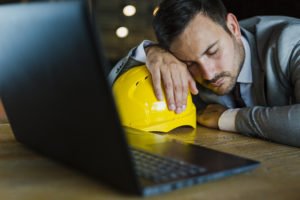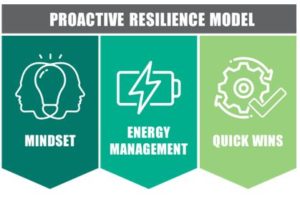Imagine this: you are sitting at your desk, facing tight deadlines with the telephone ringing every second minute; every time you start to concentrate, you are interrupted by an email notification from Outlook. Colleagues around you are chatting. You start getting headaches and your heartbeat increases. You feel irritated and tired. Over time, you realise you cannot really concentrate anymore, and you start to forget things. Your colleagues also notice that you respond to questions more aggressively than you usually would. You can’t manage work like you normally do. Does that sound familiar?
 What we experience at these moments is simple: stress. The feelings of pressure, anxiety or panic we have at our desk in the office are basically the same as our ancestors in the Stone Age would have during an encounter with a bear or a tiger. This goes back to something we now call the “fight, flight, freeze” response. Basically, if a caveman spotted danger, his body had to react quickly in order to survive. Blood transferred from his brain, his stomach and his intestines to his muscles. Adrenalin was released, and his heart began to pump more and more oxygen through his body. This enabled him to either fight the predator, flee from it or hide by freezing. What we term stress in the workplace today is essentially our body going into survival mode as our brain can’t distinguish between a tiger and a deadline. So that organisations can help employees to practice resilience, DuPont Sustainable Solutions has developed the Proactive Resilience model. The model can be applied at different levels: to the entire organisation, to leaders and to individuals. It is intended to support organisations who want to further their employees’ wellbeing and enable them to work effectively at minimal stress levels. Without such support, organisations can expect to see a high rate of staff turnover with the corresponding negative effect on consistency, quality and overall performance. Studies have shown that stress at work is associated with increased turnover intentions while further research indicates that resilience is associated with greater job satisfaction and lower stress levels, a factor that leads to lower turnover intentions[1].
What we experience at these moments is simple: stress. The feelings of pressure, anxiety or panic we have at our desk in the office are basically the same as our ancestors in the Stone Age would have during an encounter with a bear or a tiger. This goes back to something we now call the “fight, flight, freeze” response. Basically, if a caveman spotted danger, his body had to react quickly in order to survive. Blood transferred from his brain, his stomach and his intestines to his muscles. Adrenalin was released, and his heart began to pump more and more oxygen through his body. This enabled him to either fight the predator, flee from it or hide by freezing. What we term stress in the workplace today is essentially our body going into survival mode as our brain can’t distinguish between a tiger and a deadline. So that organisations can help employees to practice resilience, DuPont Sustainable Solutions has developed the Proactive Resilience model. The model can be applied at different levels: to the entire organisation, to leaders and to individuals. It is intended to support organisations who want to further their employees’ wellbeing and enable them to work effectively at minimal stress levels. Without such support, organisations can expect to see a high rate of staff turnover with the corresponding negative effect on consistency, quality and overall performance. Studies have shown that stress at work is associated with increased turnover intentions while further research indicates that resilience is associated with greater job satisfaction and lower stress levels, a factor that leads to lower turnover intentions[1].
Millennials, in particular, expect companies to provide a workplace where employees feel appreciated and safe, physically and psychologically. Organisations can demonstrate an understanding of and support in managing stress in a number of ways. Some, for example offer flexible working hours so employees can plan their day around their children’s schedules or their sporting activities or make it possible to work from home. The aim is to lower stress levels and create a trust-based and appreciative culture[2].
To develop and maintain this culture, an organisation needs authentic and empathic leaders who should be in regular dialogue with their employees to ensure they’re feeling well and capable of doing their work to their best ability. Employees should feel empowered to say that they are not able to take on another task or process, without fear of negative consequences. Leaders should also sit down and find solutions together with employees, approaching the situation with a coaching attitude.
Proactive Resilience – what it is and how it works
 The Proactive Resilience model provides organisations, business leaders and individuals with the tools needed to improvement stress management. It is based on three pillars: The foundation consists of quick wins and best practices for the prevention of both stress and stressful situations, as well as coping strategies. By quick wins we mean little tips and tricks everybody can use to decrease their personal stress level; for instance, by turning mail notifications off to ensure they can focus on work without interruption or by taking a proper lunch away from the desk. This will not only have an immediate impact but will also proactively affect tomorrow’s stressors.
The Proactive Resilience model provides organisations, business leaders and individuals with the tools needed to improvement stress management. It is based on three pillars: The foundation consists of quick wins and best practices for the prevention of both stress and stressful situations, as well as coping strategies. By quick wins we mean little tips and tricks everybody can use to decrease their personal stress level; for instance, by turning mail notifications off to ensure they can focus on work without interruption or by taking a proper lunch away from the desk. This will not only have an immediate impact but will also proactively affect tomorrow’s stressors.
The next pillar of Proactive Resilience, is energy management. If we are aware of what drains and gives us energy, we can take a deliberate decision to focus on the activities that allow us to achieve an inner balance and recharge. If we can identify things in our lives which use up our energy and stop us from having a good night’s sleep or from coming into the office with a smile, we can either keep on doing those things or we can change our perspective and behaviour. The motto is, “Love it – Change it – or Leave it.”
In addition to applying quick wins and working on our energy levels, we should also continuously address pillar three, our mindset. It is important to understand that stress is not necessarily a bad thing. When re-evaluating or reframing situations, we can distinguish between good and challenging stress and bad, self-made stress that only consumes our energy. Often an adjustment of attitude and mindset can be a big game changer. We can always switch perspective and ask ourselves, what is this situation teaching me about myself? What do I still have to learn? A good example for a change in mindset would be a traffic jam on our way back home after a day at work. Usually, we are frustrated and just want to get out of the car. But this situation also has a positive side. If we alter our mindset, we may be glad that we were not involved in the accident that caused the traffic jam. We can just enjoy the moment while singing along to our favourite song, we can turn the radio off and just enjoy the silence or learn something new while listening to a podcast.
The concept of mindset used in the Proactive Resilience model is based on research by a team of Harvard scientists in 2011[3]. The researchers showed that great amounts of stress and the perception that stress is negatively affecting our health are both associated with poor physical and mental health. The researchers even demonstrated that this combination of a large amount of stress and the perception of stress as a health risk increase the risk of premature death. In contrast, participants in the study who reported experiencing large amounts of stress but perceived that stress as not affecting their health, showed a decreased risk of premature death. This proves that we can actively increase our chances of a healthier and longer life if we change our mindset with regard to stress and stressful situations.
What you can do at an individual level
 We should all work to develop our own personal proactive resilience. It is up to us as individuals to decide whether we want to take a proactive role in living a healthy and happy life or whether we want to continue playing the role of a victim to stress. Business leaders, in particular, need to start the journey of improving resilience in their organisation by looking at and working on themselves first.
We should all work to develop our own personal proactive resilience. It is up to us as individuals to decide whether we want to take a proactive role in living a healthy and happy life or whether we want to continue playing the role of a victim to stress. Business leaders, in particular, need to start the journey of improving resilience in their organisation by looking at and working on themselves first.
To achieve a resilient life, we must constantly work at ourselves, slow ourselves down and listen to the things our body tells us. If we are not cautious, we start living in survival mode, which has negative impacts on our health. Because of the permanently increased heart rate, we may suffer from hypertension and other cardiovascular diseases. Our immune system will weaken because of the lack of nutrients we receive due to the reduced activity of our gastro internal system. This can lead to chronic diseases or inflammations. In other words, we put our health at serious risk if we do not ensure that our body gets a respite from stress. We must comprehend that – unlike our ancestors – we do not have to fight for our lives when we are at work. We therefore need to learn to differentiate between real, beneficial stress that helps us to perform and react quickly and unnecessary stress we create for no good reason. What we have to recognise is that we must relax to give our body a break from survival mode so that we have the chance to recharge our batteries, otherwise they may well one day run out. This is easier said than done.
To help people to learn how to become resilient – especially at an individual level –, DuPont Sustainable Solutions has developed the “Reframing Stress – Living Proactive Resilience” workshop. In this workshop, participants learn more about the physiology of stress and how it can affect their health. They also explore the differences between real stress and “self-made” stress. With that knowledge, participants work on quick wins which they can integrate directly in their lives. However, the focus of the workshop is to work with participants on their mindset, re-evaluating certain situations so that stress can be avoided in the first place. There is also a module for leaders which looks at team resilience, leadership roles and responsibilities.
To summarise, we must learn “to think about what we think about” in order to live a more resilient life. So, the next time you are attacked by a tiger (or a deadline), maybe you can think about this article and try to fight the stress instead of letting it chase you. You are likely to be healthier and more productive for it.
Fabian Grimm & Meike Ruppel
Fabian Grimm has been working on the topic of resilience together with DuPont Sustainable Solutions since September 2018. With a background in “Intercultural Business Psychology”, Fabian’s work focuses on mental health and resilience in intercultural organisations.
Meike Ruppel has been with DuPont Sustainable Solutions since 2015. In her role as a Learning and Development Consultant and Instructional Designer, she has worked with clients across Europe developing blended learning programmes with a focus on mindset and behaviour. She holds a master’s degree in “Work and Organisational Psychology” from Maastricht University, as well as several coaching qualifications.
[1] Ghandi, Parastoo; Hejazi, Elahe; Ghandi, Nahid (2017): A Study on the Relationship between Resilience and Turnover Intention: With an Emphasis on the Mediating Roles of Job Satisfaction and Job Stress.
[2] Capita’s Nichola Ebbern will be speaking about Wellbeing at work – differences in what ‘snowflakes’ and ‘baby boomers’ expect from their employers, and the benefits of wellbeing for recruitment and retention, at Safety & Health Expo from 18-20 June. Catch her session in the Workplace Wellbeing Theatre at 12 noon on Wednesday 19 June. Click the box below to book your free ticket.
[3] Keller, A., Litzelman, K., Wisk, L. E., Maddox, T., Cheng, E. R., Creswell, P. D., & Witt, W. P. (2011). Does the perception that stress affects health matter? The association with health and mortality. Health psychology: official journal of the Division of Health Psychology, American Psychological Association, 31(5), 677-84.
What makes us susceptible to burnout?
In this episode of the Safety & Health Podcast, ‘Burnout, stress and being human’, Heather Beach is joined by Stacy Thomson to discuss burnout, perfectionism and how to deal with burnout as an individual, as management and as an organisation.
We provide an insight on how to tackle burnout and why mental health is such a taboo subject, particularly in the workplace.

 What we experience at these moments is simple:
What we experience at these moments is simple:  The Proactive Resilience model provides organisations, business leaders and individuals with the tools needed to improvement stress management. It is based on three pillars: The foundation consists of quick wins and best practices for the prevention of both stress and stressful situations, as well as coping strategies. By quick wins we mean little tips and tricks everybody can use to decrease their personal stress level; for instance, by turning mail notifications off to ensure they can focus on work without interruption or by taking a proper lunch away from the desk. This will not only have an immediate impact but will also proactively affect tomorrow’s stressors.
The Proactive Resilience model provides organisations, business leaders and individuals with the tools needed to improvement stress management. It is based on three pillars: The foundation consists of quick wins and best practices for the prevention of both stress and stressful situations, as well as coping strategies. By quick wins we mean little tips and tricks everybody can use to decrease their personal stress level; for instance, by turning mail notifications off to ensure they can focus on work without interruption or by taking a proper lunch away from the desk. This will not only have an immediate impact but will also proactively affect tomorrow’s stressors. We should all work to develop our own personal proactive resilience. It is up to us as individuals to decide whether we want to take a proactive role in living a healthy and happy life or whether we want to continue playing the role of a victim to stress. Business leaders, in particular, need to start the journey of improving resilience in their organisation by looking at and working on themselves first.
We should all work to develop our own personal proactive resilience. It is up to us as individuals to decide whether we want to take a proactive role in living a healthy and happy life or whether we want to continue playing the role of a victim to stress. Business leaders, in particular, need to start the journey of improving resilience in their organisation by looking at and working on themselves first.